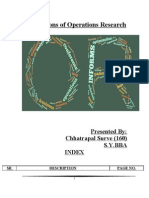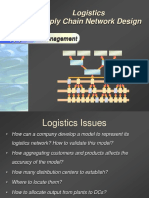Geometric Programming Lecture
Uploaded by
manendra chopraGeometric Programming Lecture
Uploaded by
manendra chopraGEOMETRIC PROGRAMMING
Geometric programming is an optimization technique.
Geometric programming is relatively a new
technique, for solving linear / non linear
optimization problems subject to linear / non linear
constraints.
Geometric programming has wide applications in
many fields of engineering.
e.g. (i) Machine Design Pressure Vessel, Bearing
(ii) Metal Cutting
(iii) Dam Design Civil Engineering
Geometric programming can handle easily objective
function and constraints with any odd powers of
variables. (Conventional N.L.P. methods easily
handle only quadratic form of objective functions and
constraints).
Geometric programming is an efficient technique
in complicated cases, where other techniques fail.
Geometric programming is based on The arithmetic-
geometric mean inequality relationship.
2 1
2 1
2
x x
x x
- >
+
Many times a problem, not directly solvable by
Geometric Programming can be formulated / converted
such that G. P. can be easily applicable.
At optimality each term of objective function is a
fixed percentage of optimal value of function .
General Geometric Programming problem :
[
= =
=
0
1 1
) (
T
t
N
n
t a
n ot ot o
n o
x C x y Min o
m
T
t
N
n
a
n mt mt
m
mtn
x C t s o o s
[
= = 1 1
/
m = 1, 2, ...M, x
n
> 0, n = 1, 2, ....N
Where
o o o
mt ot m
= = = 1 1 1 , ,
C
mt
> 0, C
ot
> 0
a
mtn
, a
otn
are unrestricted in sign.
T
m
= Number of terms in m
th
constraint
T
o
= Number of terms in objective function
T = Total number of terms =
T
m
m
M
=
0
If all o are positive, then the problem is called
posynomial otherwise sinomial.
The degree of difficulty is defined based on
number of variables and total number of terms in a
problem.
Degree of difficulty = T - (N + 1)
A problem can be
(i) Unconstrained or
(ii) Constrained
Unconstrained problem (Polynomial)
[
= = =
= =
To
t
N
n
a
n
T
t
t t t o
otn
o
x C x P C x y Min
1 1 1
) ( ) (
The arithmetic-geometric mean inequality relationship :
3
2
3
1 3
5 . 1
2
3
1 2
1 . 2
2
3
1 1
. . x x C x x C x x C y Min g e
+ + - =
3 / 1
3
3 / 1
2
3 / 1
1 3 2 1
2 / 1
2
2 / 1
1 2 1
2 1
2 1
3
1
3
1
3
1
2
1
2
1
. .
2
x x x x x x IIly
x x x x e i
x x
x x
- - > + +
- > +
- >
+
For any positive numbers
1
,
2
, ...
T
and set of
positive weight w
1
, w
2
, ...w
T
, such that
=
=
T
t
t
w
1
1
[
= =
>
T
t
T
t
w
t t t
t
v w v
1 1
) (
Now
t
otn otn
w
T
t
t
N
n
a
n t
t
N
n
a
n t
t
w
x C
w
x C
w
[
[
[
=
= =
(
(
(
(
>
1
1 1
To be minimized To be maximized
(
(
-
(
(
|
|
.
|
\
|
>
|
|
|
|
.
|
\
|
[ [
[
= = =
=
=
N
n
w a
n
T
t
w
t
t
T
t
t
N
n
a
n t
t
o
T
t
t otn
o
t
o
otn
x
w
C
w
x C
w
1
.
1 1
1
1
If for n = 1, 2, 3, ... N, then
a w
otn t
t
T
o
=
=
0
1
t
o o
otn
w
T
t
T
t
t
t
N
n
a
n t
w
C
x C
[ [
= = =
|
|
.
|
\
|
>
1 1 1
t
o
w
T
t
t
t
w
C
y
[
=
-
|
|
.
|
\
|
=
0
s/t
w
t
t
T
o
=
=
1
1
Normality condition
a w
otn t
t
T
o
=
=
0
1
and
for n = 1, 2, ... N.
Orthogonality conditions
Application :
3
2
3
1 3
5 . 1
2
3
1 2
1 . 2
2
3
1 1
x x C x x C x x C y Min
+ + =
= + +
= +
= + +
0 3 5 . 1 1 . 2
0 3 3 3
1
3 2 1
3 2 1
3 2 1
w w w
w w w
w w w
3 2 1
3
3
2
2
1
1
w w w
w
C
w
C
w
C
y
|
|
.
|
\
|
-
|
|
.
|
\
|
-
|
|
.
|
\
|
=
-
- =
- =
- =
-
-
-
y w x x C
y w x x C
y w x x C
3
3
2
3
1 3
2
5 . 1
2
3
1 2
1
1 . 2
2
3
1 1
gives
x
1
= ______
x
2
= ______
Constrained Problem :
0 , ,
1 . . .
1 . . . /
. . . . . .
3 2 1
3 2 1 21
3 2 1 11
3 2 1 02 3 2 1 01
23 22 21
13 12 11
06 05 04 03 02 01
>
s
s
+ =
x x x where
x x x K
x x x K t s
x x x K x x x K y Min
A A A
A A A
A A A A A A
If only 2 constraints are considered, then the problem
will be of Zero degree of difficulty.
( ) ( )
21 11
02 01
21 11
02
02
01
01
23 21 13 11 06 02 03 01
22 21 12 11 05 02 02 01
21 21 11 11 04 02 01 01
02 01
. . .
0 . . . .
0 . . . .
0 . . . .
1
w w
w w
K K
w
K
w
K
y
A w A w A w A w
A w A w A w A w
A w A w A w A w
w w
|
|
.
|
\
|
|
|
.
|
\
|
=
= + + +
= + + +
= + + +
= +
-
GP
01 02 03 04 05 06
07 08 09 10
13 11 12 14
23 21 22 24
25 26 27 24
01 1 2 3 02 1 2 3
03 1 2 3 4
11 1 2 3 4
21 1 2 3 4
22 1 2 3 4
. . . . . .
. . . .
/ . . . . 1
. . . .
. . . . 1
0
A A A A A A
A A A A
A A A A
A A A A
A A A A
j
Min y K x x x K x x x
K x x x x
s t K x x x x
K x x x x
K x x x x
All x
= + +
s
+
s
>
DGP
( )
( ) ( )
22 21 22
22
20 22
21
20 21
11
03
03
02
02
01
01
22 21
11
03 02 01
.
. . . .
w w w where
w
w K
w
w K
K
w
K
w
K
w
K
y Max
w w
w
w w w
+ =
)
`
)
`
|
|
.
|
\
|
|
|
.
|
\
|
|
|
.
|
\
|
=
0 . . . .
0 . . . . . .
0 . . . . . .
0 . . . . . .
1 /
27 22 24 21 14 11 10 03
26 22 23 21 13 11 09 03 06 02 03 01
25 22 22 21 12 11 08 03 05 02 02 01
24 22 21 21 11 11 07 03 04 02 01 01
03 02 01
= + + +
= + + + + +
= + + + + +
= + + + + +
= + +
A w A w A w A w
A w A w A w A w A w A w
A w A w A w A w A w A w
A w A w A w A w A w A w
w w w t s
2 1 2
3
1
3
2
2
1
. . 3 . . 8 . . 2 x x x x x x Z Min + + =
Numericals - GP
(1)
(2)
3 3 2 1
1 2 1 2 1 2 1 2
2 . . 4 . . . 8 . . Min Z x x x x x x x x
= + + +
(3)
1 2 3
1 2 2 3 1 2 3 1 2 3
7 . . 3 . . 5. . . . . Min Z x x x x x x x x x x
= + + +
(4)
1 1 1
1 2 3 2 3 1 2 1 3
40 . . . 40 . . 20 . 10 . . Min Z x x x x x x x x x
= + + +
(5)
1 1 4 4 1.15
2.75 11.74 * 10
/ 71.5 1
Min Z V f V f
s t f
= +
s
You might also like
- Hourglass Workout Program by Luisagiuliet 276% (21)Hourglass Workout Program by Luisagiuliet 251 pages
- Read People Like A Book by Patrick King-Edited58% (81)Read People Like A Book by Patrick King-Edited12 pages
- Livingood, Blake - Livingood Daily Your 21-Day Guide To Experience Real Health77% (13)Livingood, Blake - Livingood Daily Your 21-Day Guide To Experience Real Health260 pages
- Donald Trump & Jeffrey Epstein Rape Lawsuit and Affidavits83% (1016)Donald Trump & Jeffrey Epstein Rape Lawsuit and Affidavits13 pages
- The 36 Questions That Lead To Love - The New York Times94% (34)The 36 Questions That Lead To Love - The New York Times3 pages
- The 36 Questions That Lead To Love - The New York Times95% (21)The 36 Questions That Lead To Love - The New York Times3 pages
- 14 Easiest & Hardest Muscles To Build (Ranked With Solutions)100% (8)14 Easiest & Hardest Muscles To Build (Ranked With Solutions)27 pages
- Jeffrey Epstein39s Little Black Book Unredacted PDF75% (12)Jeffrey Epstein39s Little Black Book Unredacted PDF95 pages
- The 4 Hour Workweek, Expanded and Updated by Timothy Ferriss - Excerpt23% (954)The 4 Hour Workweek, Expanded and Updated by Timothy Ferriss - Excerpt38 pages
- Solution Key Comprehensive Question PaperNo ratings yetSolution Key Comprehensive Question Paper8 pages
- Lagrange Multiplier Presentation 06oct 15No ratings yetLagrange Multiplier Presentation 06oct 1533 pages
- Operations Research With Case Study On GM and Ford100% (1)Operations Research With Case Study On GM and Ford15 pages
- Chapter 9 Appendix: Acceptance Sampling Fundamentals100% (1)Chapter 9 Appendix: Acceptance Sampling Fundamentals11 pages
- Exam 1 - Programming PHP Practice QuestionsNo ratings yetExam 1 - Programming PHP Practice Questions2 pages
- Classical & Advanced Optimization Techniques PDFNo ratings yetClassical & Advanced Optimization Techniques PDF12 pages
- L31 - Non-Linear Programming Problems - Unconstrained Optimization - KKT Conditions100% (1)L31 - Non-Linear Programming Problems - Unconstrained Optimization - KKT Conditions48 pages
- Answers - Mid Term Exam Advanced Project Management Arab AcademyNo ratings yetAnswers - Mid Term Exam Advanced Project Management Arab Academy14 pages
- Chap15 Demand Management and ForecastingNo ratings yetChap15 Demand Management and Forecasting51 pages
- Production and Operations Management: MENG 7037No ratings yetProduction and Operations Management: MENG 703780 pages
- PPT2 - W1-S2 - Simplex Method & Duality Theory-R0No ratings yetPPT2 - W1-S2 - Simplex Method & Duality Theory-R073 pages
- Lecture 01 Introduction To Product Design and Development100% (2)Lecture 01 Introduction To Product Design and Development17 pages
- Lecture 1 - Chapter 1 - Productivity and Quality of Life ....100% (1)Lecture 1 - Chapter 1 - Productivity and Quality of Life ....38 pages
- TABLE I - Sample Size Code Letters: MIL-STD-105E ofNo ratings yetTABLE I - Sample Size Code Letters: MIL-STD-105E of7 pages
- Decision Making Using The Analytic Hierarchy Process (AHP) A Step by Step ApproachNo ratings yetDecision Making Using The Analytic Hierarchy Process (AHP) A Step by Step Approach4 pages
- Cloud Computing-Based Manufacturing Resources Configuration Method100% (1)Cloud Computing-Based Manufacturing Resources Configuration Method14 pages
- What Is Value Analysis & Value EngineeringNo ratings yetWhat Is Value Analysis & Value Engineering5 pages
- Logistics Supply Chain Network Design: ManagementNo ratings yetLogistics Supply Chain Network Design: Management50 pages
- Benefit Cost Ratio Analysis and Payback PeriodNo ratings yetBenefit Cost Ratio Analysis and Payback Period20 pages
- Jimma Institute of Technology: Product Design Lecture-IINo ratings yetJimma Institute of Technology: Product Design Lecture-II18 pages
- Unit 2 Lecture 3 Linear Programming & Simplex Method100% (1)Unit 2 Lecture 3 Linear Programming & Simplex Method46 pages
- Design For X' (DES 508) : Dr. Arivazhagan. A IIITD&M, KancheepuramNo ratings yetDesign For X' (DES 508) : Dr. Arivazhagan. A IIITD&M, Kancheepuram67 pages
- FALLSEM2023-24 EEE1020 ETH VL2023240103124 2023-07-27 Reference-Material-INo ratings yetFALLSEM2023-24 EEE1020 ETH VL2023240103124 2023-07-27 Reference-Material-I16 pages
- Hardware Sales Forecasting Using Clustering and Machine Learning ApproachNo ratings yetHardware Sales Forecasting Using Clustering and Machine Learning Approach11 pages
- Input Source Encoder Channel Encoder Binary InterfaceNo ratings yetInput Source Encoder Channel Encoder Binary Interface29 pages
- BSCM-04 Estimation of Distribution AlgorithmsNo ratings yetBSCM-04 Estimation of Distribution Algorithms9 pages
- LTI System (Linear Time Invariant) ImplementationNo ratings yetLTI System (Linear Time Invariant) Implementation16 pages
- An Introduction To Supervised Machine Learning and Pattern Classification - The Big PictureNo ratings yetAn Introduction To Supervised Machine Learning and Pattern Classification - The Big Picture55 pages
- Unit-4 3D Concepts & Object Representation: 2160703 Computer GraphicsNo ratings yetUnit-4 3D Concepts & Object Representation: 2160703 Computer Graphics87 pages
- Question Bank (2014) MAM-581, Engineering Mathematics V: Unit#2 16No ratings yetQuestion Bank (2014) MAM-581, Engineering Mathematics V: Unit#2 167 pages
- Rainfall Prediction Using Random Forest RegressorNo ratings yetRainfall Prediction Using Random Forest Regressor10 pages























































































































